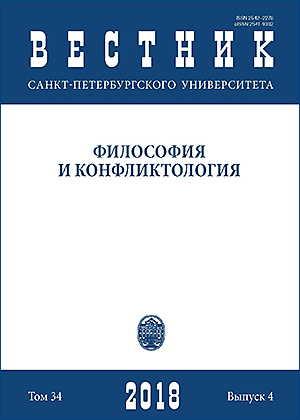Политики медиа и эстетика
DOI:
https://doi.org/10.21638/spbu17.2018.411Аннотация
Статья посвящена сравнительному анализу трансформации эстетического подхода в эпоху медиального поворота. Каким образом изменяется предмет эстетики, ее принципы и методы, как медианалитика влияет на традиционный эстетический анализ, тематизацию ее предмета. Для этого рассматриваются две крайние позиции апологии эстетики и ее радикальной критики. Выделяется принципиальная особенность медиаанализа, которому присущи безоценочное суждение, формальность и эмоциональная безучастность. Эстетика же сохраняет продуктивность своего оценочного ресурса. У медиа есть свои интересы, свои способы добиваться их. Для этого медиа использует ресурс эстетики. Однако роль эстетики в достижении власти медиа недостаточно изучена. Анализ взаимоотношения политик медиа и эстетического режима позволит определить как собственную специфику политик медиа, направленных на самоучреждение и самообоснование, так и новые горизонты эстетики. У эстетики есть своя политика. Ставится острый вопрос о той сфере, которая не дается эстетике, на которые она не может набросить сеть своих категорий, что вновь свидетельствует о неустранимости внеэстетического опыте. И напротив, то, что подводится под категорию эстетического утрачивает модус актуальности, переходя в нормативный режим искусства или легитимную страницу истории культуры. Подмечена закономерность, чем стройнее история эстетики и чем яснее ее основания и критерии саморефлексии, тем более сильную волю к блокированию ее подлинного ресурса мы наблюдаем. Иными словами, воля к истории, конструируемая исходя из оставшихся в прошлом веке принципов ее самоописания, ведет к стагнации эстетики.
Ключевые слова:
медиа, эстетика, политика, оценка, перформанс, актуальное искусство
Скачивания
Библиографические ссылки
Mediareal’nost’: koncepty i kul’turnye praktiki [Media reality: concerts and cultural practices], textbook. Fond razvitiia konfliktologii, St. Petersburg, Russia.
Загрузки
Опубликован
Как цитировать
Выпуск
Раздел
Лицензия
Статьи журнала «Вестник Санкт-Петербургского университета. Философия и конфликтология» находятся в открытом доступе и распространяются в соответствии с условиями Лицензионного Договора с Санкт-Петербургским государственным университетом, который бесплатно предоставляет авторам неограниченное распространение и самостоятельное архивирование.






